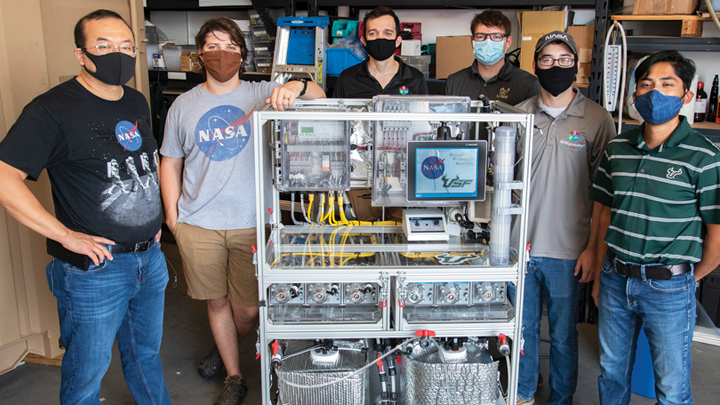University
USF Technology Being Tested for Possible Use on Moon Mission
By ALTHEA PAUL | USF News
A TECHNOLOGY CREATED AT USF is now at NASA’s Kennedy Space Center, where its effectiveness under simulated space mission conditions is being tested.
Civil and Environmental Engineering Professor Daniel Yeh has been collaborating with NASA to develop a system that converts human waste into fertilizer and water, which would allow astronauts to grow fresh vegetables in space in a more sustainable way. It could help enable the establishment of a permanent presence on the moon.
Yeh’s invention, the Organic Processor Assembly, is a closed system the size of a miniature fridge and automatically extracts nutrients directly from the toilet. It uses some of the same principles of his NEWGenerator resource recovery machine, which converts human waste into clean water, energy and fertilizer, and is currently being used in India and South Africa.

“Over the years, our team has gotten pretty good at coming up with technologies that work well on Earth,” Yeh says. “Developing resource recovery solutions for space was something new. It presented a whole new series of design challenges to overcome, such as those related to mass, volume, modularity and reduced gravity.”
NASA’s lunar exploration program, Artemis, is working to return humans to the moon in 2024. NASA landed the first man on the moon with Apollo 11 in 1969, and Artemis is the first time a woman is set to land on the moon. It puts the agency one step closer to sending astronauts to Mars.
Over the last decade, there have been nearly 40 expeditions to the International Space Station, which is in orbit more than 250 miles above Earth, traveling faster than 17,000 mph. Comparatively, the moon is 238,900 miles away, making it far more difficult to restock supplies and nearly impossible to dump waste. Mars, which takes six to eight months to get to, will be even more challenging for resupply.
Building on previous experiments, astronauts aboard the International Space Station have grown small amounts of produce, such as lettuce, cabbage and kale, since 2014 through the Vegetable Production System, known as VEGGIE. The Organic Processor Assembly aims to eliminate the need to transport fertilizer, as it is created on-site. It facilitates growing fresh produce to supplement the astronauts’ diet on long duration missions, which is also great for psychological reasons, especially since living things can serve as a reminder of home.
“NASA can only resupply a limited mass and volume to the moon and Mars habitats. This limitation forces research advancements to provide a reliable, closed-loop system between food consumption and production,” says Luke Roberson, NASA’s principal investigator. “With the OPA technology, we’re investigating if we can sustainably begin recycling human wastewater resources into potable water and fertilizer nutrients. There is a big difference between a fresh and canned strawberry in both nutrient content and interaction with your senses.”
Earlier this year, Yeh, Roberson, USF graduate student Talon Bullard ’18 and former USF postdoc Melanie Pickett MEVE ’15, PhD ’18, -won the Kennedy Space Center’s 2020 Sustainable Environmental Awareness Award. A patent has also been issued and other patents are pending. So far, Yeh has received more than $340,000 in grant funding from NASA. This includes a seed grant awarded in 2018 that allowed Bullard to start developing a prototype for the Organic Processor Assembly.
NASA is expected to decide if the technology will be sent to the moon over the next two to three years. A second unit of the Organic Processor Assembly will remain at USF for further testing.